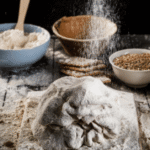Flour maize, commonly known as corn flour in many regions, stands as one of the most transformative agricultural products in human history. From ancient civilizations that first domesticated maize in the Americas to today’s global food markets, the product of finely ground maize kernels has been a staple of both survival and cultural expression. For the searcher intent, flour maize refers to maize that has been ground into a soft powder, primarily used for baking, cooking, and thickening foods. It is not only a cornerstone of traditional diets but also an economic driver across continents. Understanding flour maize involves exploring its origin, nutritional properties, milling processes, cultural influence, and role in shaping sustainable food systems. In recent years, renewed interest in maize flour has emerged, fueled by gluten-free diets, innovations in agricultural technology, and the push toward more resilient staple crops in the face of climate change. This article provides a comprehensive exploration of flour maize, tracing its journey from ancient fields to modern kitchens while offering readers fresh insights into its evolving place in global food culture. As one historian once remarked, “Maize is not just food—it is the story of civilization in every kernel.”
Historical Origins of Flour Maize
The story of flour maize begins nearly 9,000 years ago in the valleys of southern Mexico, where indigenous peoples domesticated wild teosinte into what we now recognize as maize. Unlike wheat or barley, maize required deliberate cultivation and genetic selection to evolve into a reliable crop. Once domesticated, it spread rapidly through the Americas, becoming central to the diets of civilizations such as the Maya, Aztec, and Inca. Grinding maize into flour was both a culinary necessity and a cultural ritual, often involving stone tools like the metate. The flour produced was used to make tortillas, tamales, and other foundational foods that carried deep spiritual and social significance. When European explorers introduced maize to other continents in the 16th century, it quickly became a global crop, adapting to diverse climates and transforming local cuisines. Maize flour entered Europe not just as an ingredient but as a solution to famine, offering a high-yield food source that sustained populations during agricultural crises.
Nutritional Composition of Maize Flour
Flour maize is rich in carbohydrates, making it a significant energy source for millions. However, its nutritional value extends beyond calories. It contains moderate levels of protein, dietary fiber, and essential micronutrients like magnesium, phosphorus, and B-vitamins. Depending on processing, maize flour can retain valuable phytonutrients such as carotenoids, which contribute to eye health. Unlike wheat flour, maize flour is naturally gluten-free, making it a vital option for people with celiac disease or gluten sensitivity. Still, traditional maize flour can be deficient in certain amino acids, particularly lysine and tryptophan, which has historically led to health issues like pellagra in maize-dominated diets. Modern nutritional science has addressed these challenges through biofortification and the development of quality protein maize (QPM). These advancements ensure that maize flour continues to nourish populations while reducing the risks of malnutrition.
Milling and Processing Techniques
The process of transforming maize kernels into flour has evolved dramatically over centuries. Traditional stone milling techniques involved labor-intensive grinding, producing flour with variable texture and nutritional retention. Today, industrial milling employs roller mills and hammer mills to ensure consistent quality. Beyond physical grinding, some cultures developed chemical processing methods such as nixtamalization, where maize is soaked and cooked in an alkaline solution. This technique, common in Mesoamerican traditions, enhances the nutritional profile of maize flour by increasing calcium content, improving digestibility, and releasing niacin. Modern milling often balances efficiency with nutritional preservation, offering whole-grain maize flour that retains the germ and bran or refined varieties with longer shelf life. As consumer demand shifts toward health-conscious and minimally processed foods, artisanal milling methods are regaining popularity, highlighting a growing appreciation for both heritage and nutrition.
Culinary Applications Across Cultures
Maize flour plays a central role in global cuisines, reflecting local traditions and adaptations. In Latin America, it forms the backbone of dishes like tortillas, arepas, and tamales, each with regional variations. In Africa, maize flour’s used to make staples such as ugali in East Africa and sadza in Zimbabwe, foods that embody community and daily sustenance. In southern Europe, polenta remains a comforting dish with centuries of culinary heritage. Meanwhile, in North America, cornmeal-based products like cornbread and grits have become cultural icons. Maize flours also serves as a thickening agent in soups, sauces, and desserts worldwide. Its versatility makes it indispensable not just as food but as a symbol of cultural resilience. As one chef observed, “Maize flour’s memory ground into powder—each recipe is a connection to ancestry.”
Economic Importance of Flour Maize
Maize is one of the world’s most cultivated crops, and flour maize constitutes a vital component of its economic impact. For smallholder farmers, maize flour provides both income and subsistence, while for large agribusinesses, it represents a product with diverse market potential. The maize flours industry includes commercial flour mills, packaged consumer products, and large-scale food service suppliers. Its trade networks extend across continents, influencing economies from rural villages to global corporations. Moreover, maize flours has implications for food security, as it can be stored, transported, and distributed efficiently to address hunger in vulnerable regions. The balance between industrial production and community-based milling highlights the economic duality of maize flours: it sustains local livelihoods while driving international trade.
Global Consumption Trends
Consumption of maize flour continues to expand globally, driven by demographic growth, cultural preferences, and dietary shifts. In many African nations, it accounts for a majority of daily caloric intake, reinforcing its role as a staple. In Europe and North America, health-conscious consumers increasingly seek gluten-free maize flour as an alternative to wheat. Additionally, urbanization has fueled demand for ready-to-cook maize flours products, bridging convenience with tradition. In regions affected by climate change, maize flour’s resilience as a crop makes it an essential food security tool. These global patterns reflect maize flour’s adaptability not only to different palates but also to diverse social and environmental contexts.
Table 1: Nutritional Composition of Maize Flour (per 100g)
| Component | Amount | Health Benefit |
|---|---|---|
| Carbohydrates | 73g | Primary energy source |
| Protein | 8g | Supports muscle and tissue repair |
| Dietary Fiber | 7g | Aids digestion and satiety |
| Fat | 3.5g | Provides essential fatty acids |
| Magnesium | 127mg | Supports bone health and metabolism |
| Phosphorus | 250mg | Crucial for energy production |
| Vitamin B3 (Niacin) | 3.6mg | Helps energy release and nerve function |
| Carotenoids | Variable | Antioxidants, supports eye health |
Table 2: Major Cultural Uses of Flour Maize
| Region | Traditional Dish | Cultural Significance |
|---|---|---|
| Latin America | Tortillas | Daily staple, spiritual symbolism |
| East Africa | Ugali | Community food, central to meals |
| Southern Africa | Sadza | Shared heritage, symbol of resilience |
| Southern Europe | Polenta | Comfort food, rustic tradition |
| North America | Cornbread | Regional identity, southern cuisine icon |
| Caribbean | Fritters | Festive food, blended culinary heritage |
Environmental Impact and Sustainability
Flour maize cannot be separated from the environmental realities of maizes cultivation. Maize production demands significant water and land resources, raising questions about sustainability. However, maize is also one of the most adaptable crops, capable of thriving in varied climates. Innovations in crop breeding have produced drought-resistant and pest-resistant varieties, offering hope for sustainable maize flours production in the future. Furthermore, local milling reduces carbon footprints associated with transportation. The push toward organic maize flours and regenerative agriculture represents broader environmental consciousness among consumers and producers alike. As climate change continues to reshape agricultural landscapes, maize flours stands as both a challenge and an opportunity for sustainable food systems.
Health Benefits and Risks
Maize flour’s health benefits are significant, particularly in providing gluten-free energy and essential micronutrients. Whole-grain maize flours enhances digestive health, while carotenoids protect against age-related eye diseases. Its versatility makes it suitable for diverse dietary needs. However, overreliance on maize flours without dietary diversity can lead to nutritional deficiencies. The risk of pellagra historically underscored the importance of processing methods like nixtamalization and balanced diets. Today, fortification and dietary education are critical to maximizing benefits while minimizing risks. Consumers are advised to choose whole-grain and fortified varieties to ensure optimal health outcomes.
Modern Innovations in Maize Flour
Advancements in food science have redefined maize flours applications. Beyond traditional uses, maize flours now appears in gluten-free baked goods, snack foods, and even health supplements. Researchers are exploring maize flours as a base for functional foods enriched with probiotics, omega-3s, and plant proteins. In industrial contexts, maize flours has non-food applications, including biodegradable packaging and cosmetic products. These innovations reflect maize flour’s expanding role in a world increasingly concerned with nutrition, convenience, and sustainability. As one agricultural scientist aptly noted, “Maize flour’s no longer just about survival—it is about reimagining the future of food.”
The Cultural Symbolism of Flour Maize
Throughout history, maize flours has carried symbolic weight beyond nutrition. In Mesoamerican civilizations, it was considered a divine gift, often tied to myths of creation. In Africa, sharing maize flour-based meals remains an act of hospitality and unity. In modern diasporas, traditional maize flours dishes serve as cultural anchors for communities navigating identity in new lands. Its presence in festivals, rituals, and daily meals reflects an enduring symbolism that transcends borders. Flour maizes thus embodies more than sustenance—it is a narrative of belonging and continuity.
Conclusion
Flour maize is more than just a staple ingredient—it is a cornerstone of civilization, health, economy, and identity. From its ancient roots in the Americas to its global presence today, maize flour has continually adapted to the needs and challenges of humanity. Its nutritional potential, economic importance, cultural significance, and modern innovations ensure that it remains central to global food systems. While it faces challenges of sustainability and nutritional balance, its resilience and versatility provide a pathway toward a more secure and culturally rich future. In a world searching for foods that sustain both body and heritage, flour maize endures as a remarkable example of how one grain can tell the story of humanity itself.
FAQs
Q1: What is the difference between maize flour and cornmeal?
Maize flour’s finely ground, soft in texture, and used in baking or thickening, while cornmeal is coarser, producing grainier textures for dishes like cornbread and polenta.
Q2: How is nixtamalized maize flour different from regular maize flour?
Nixtamalized flour undergoes alkaline treatment, enhancing nutrition by releasing niacin, adding calcium, and improving digestibility, essential in traditional tortillas.
Q3: Is maize flours suitable for gluten-free diets?
Yes, maize flour’s naturally gluten-free, making it a key ingredient for celiac-friendly diets and gluten-sensitive consumers worldwide.
Q4: What are the main health risks of relying solely on maize flour?
Exclusive maize flour diets can cause deficiencies, notably pellagra, due to lack of niacin and amino acids unless balanced with other foods.
Q5: How is maize flour contributing to sustainable food systems?
Through drought-resistant maize varieties, organic cultivation, and localized milling, maize flours supports sustainability while reducing food insecurity in vulnerable regions.











